
Banksia integrifolia, commonly known as the coast banksia, is a species of tree that grows along the east coast of Australia. One of the most widely distributed Banksia species, it occurs between Victoria and Central Queensland in a broad range of habitats, from coastal dunes to mountains. It is highly variable in form, but is most often encountered as a tree up to 25 metres (82 ft) in height. Its leaves have dark green upper surfaces and white undersides, a contrast that can be striking on windy days.

Banksia aculeata, commonly known as prickly banksia, is a species of plant of the family Proteaceae native to the Stirling Range in the southwest of Western Australia. A shrub up to 2 m (7 ft) tall, it has dense foliage and leaves with very prickly serrated margins. Its unusual pinkish, pendent (hanging) flower spikes, known as inflorescences, are generally hidden in the foliage and appear during the early summer. Although it was collected by the naturalist James Drummond in the 1840s, Banksia aculeata was not formally described until 1981, by Alex George in his monograph of the genus.

Banksia canei, commonly known as the mountain banksia, is a species of shrub that is endemic to southeastern Australia. It is generally encountered as a many-branched shrub that grows up to 3 m (10 ft) high, with narrow leaves and the yellow inflorescences appearing from late summer to early winter. The old flowers fall off the spikes and up to 150 finely furred follicles develop, which remain closed until burnt in a bushfire. Each follicle bears two winged seeds. Response to fire is poorly known, although it is thought to regenerate by seed. Birds such as the yellow-tufted honeyeater and various insects forage among the flower spikes. It is frost tolerant in cultivation, but copes less well with aridity or humidity and is often short-lived in gardens. One cultivar, Banksia 'Celia Rosser', was registered in 1978, but has subsequently vanished.

Banksia marginata, commonly known as the silver banksia, is a species of tree or woody shrub in the plant genus Banksia found throughout much of southeastern Australia. It ranges from the Eyre Peninsula in South Australia to north of Armidale, New South Wales, and across Tasmania and the islands of Bass Strait. It grows in various habitats, including Eucalyptus forest, scrub, heathland and moorland. Banksia marginata varies widely in habit, ranging from a 20-centimetre (7.9 in) shrub to a 12-metre (40 ft) tree. The narrow leaves are linear and the yellow inflorescences occur from late summer to early winter. The flower spikes fade to brown and then grey and develop woody follicles bearing the winged seeds. Originally described by Antonio José Cavanilles in 1800, further collections of B. marginata were designated as several separate species by Robert Brown in 1810. However, all were reclassified as a single species by George Bentham in 1870. No distinct subspecies have been recognised by Banksia expert Alex George, who nonetheless concedes that further work is needed.

Banksia oblongifolia, commonly known as the fern-leaved, dwarf or rusty banksia, is a species in the plant genus Banksia. Found along the eastern coast of Australia from Wollongong, New South Wales in the south to Rockhampton, Queensland in the north, it generally grows in sandy soils in heath, open forest or swamp margins and wet areas. A many-stemmed shrub up to 3 m (9.8 ft) high, it has leathery serrated leaves and rusty-coloured new growth. The yellow flower spikes, known as inflorescences, most commonly appear in autumn and early winter. Up to 80 follicles, or seed pods, develop on the spikes after flowering. Banksia oblongifolia resprouts from its woody lignotuber after bushfires, and the seed pods open and release seed when burnt, the seed germinating and growing on burnt ground. Some plants grow between fires from seed shed spontaneously.

Banksia paludosa, commonly known as the marsh or swamp banksia, is a species of shrub in the plant genus Banksia. It is native to New South Wales, Australia, where it is found between Sydney and Batemans Bay, with an isolated population further south around Eden. There are two recognised subspecies, the nominate of which is a spreading shrub to 1.5 m (4.9 ft) in height, and subsp. astrolux is a taller shrub to 5 m (16 ft) high found only in Nattai National Park.
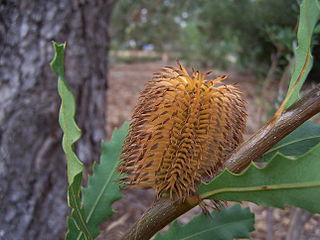
Banksia quercifolia, commonly known as the oak-leaved banksia, is a species of shrub that is endemic to the southwestern coast of Western Australia. It has smooth, greenish bark, wavy, wedge-shaped, serrated leaves, yellow, orange or brown flowers in cylindrical spikes, followed by broadly linear follicles surrounded by the remains of the flowers.

Banksia saxicola, the rock banksia or Grampians banksia, is a species of tree or shrub in the plant genus Banksia. It occurs in Victoria in two distinct populations, one in The Grampians and the other on Wilsons Promontory. Formerly considered to be a form of B. integrifolia, it was described as a distinct species by Alex George in 1981. It is most closely related to Banksia marginata.
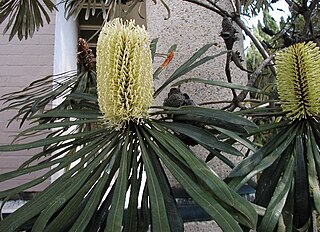
Banksia aquilonia, commonly known as the northern banksia and jingana, is a tree in the family Proteaceae and is endemic to north Queensland on Australia's northeastern coastline. With an average height of 8 m (26 ft), it has narrow glossy green leaves up to 20 cm (7.9 in) long and 6 to 10 cm high pale yellow flower spikes, known as inflorescences, appearing in autumn. As the spikes age, their flowers fall off and they develop up to 50 follicles, each of which contains two seeds.

Banksia obovata, commonly known as wedge-leaved dryandra, is a species of shrub that is endemic to Western Australia. It has hairy stems, serrated, wedge-shaped to egg-shaped leaves with the lower end towards the base, cream-coloured or pale yellow flowers in heads of up to 100, and egg-shaped follicles. It is found in near-coastal areas in the south of the state.
Banksia glaucifolia is a species of shrub that is endemic to Western Australia. It has deeply serrated, wedge-shaped leaves with sharply pointed lobes, pale yellow flowers and follicles with hairy edges.
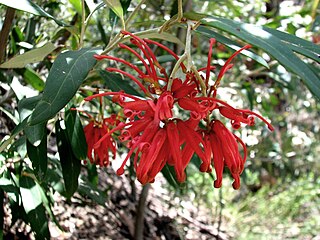
Grevillea victoriae, also known as royal grevillea or mountain grevillea, is a species of flowering plant in the family Proteaceae and is endemic to mountainous regions of south-eastern continental Australia. It is an erect to spreading shrub with elliptic to lance-shaped leaves, and pendulous clusters of red to orange flowers.

Prostanthera galbraithiae, commonly known as Wellington mint-bush, is a species of flowering plant in the family Lamiaceae and is endemic to Victoria in Australia. It is an erect or spreading shrub with densely hairy branches that are more or less square in cross-section, narrow egg-shaped or oblong leaves with the edges rolled under, and deep mauve to purple flowers with maroon dots inside the petal tube.
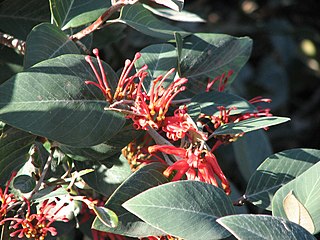
Grevillea burrowa, commonly known as Burrowa grevillea, is a species of flowering plant in the family Proteaceae and is endemic to a restricted area of Victoria, Australia. It is a spreading shrub with oblong to egg-shaped leaves, and clusters of reddish-pink flowers.

Grevillea polychroma , commonly known as Tullach Ard grevillea, is a species of flowering plant in the family Proteaceae and is endemic to eastern Victoria. It is a spreading to erect shrub with densely hairy branchlets, egg-shaped leaves, the narrower end towards the base, and down-turned clusters of hairy, cream-coloured, pale yellow or pink to red flowers.
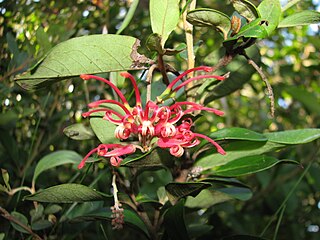
Grevillea miqueliana is a species of flowering plant in the family Proteaceae and is endemic to Victoria in Australia. It is an erect to spreading shrub with elliptic to egg-shaped leaves and clusters of red and orange or yellow flowers.
Eucalyptus croajingolensis, commonly known as the East Gippsland peppermint or Gippsland peppermint, is a species of tree that is endemic to southeastern Australia. It has rough, short-fibrous bark on the trunk and larger branches, sometimes smooth bark on the thinner branches, lance-shaped to curved adult leaves, flower buds in groups of nine or more, white flowers and hemispherical to cup-shaped fruit.
Hakea asperma, commonly known as the Native Dog hakea, is an endangered shrub of the Proteaceae endemic to a small area in northeastern Victoria. An unusual species that has no fruit and only reproduces by suckering.
Acacia infecunda, also known as famine wattle, is a shrub belonging to the genus Acacia and the subgenus Phyllodineae that is native to parts of south eastern Australia.

Leptospermum glabrescens, commonly known as the smooth teatree, is a shrub or small tree that is endemic to East Gippsland in Victoria, Australia. It has linear, elliptic or narrow egg-shaped leaves, white flowers arranged singly on short side shoots and fruit that remain on the plant.















